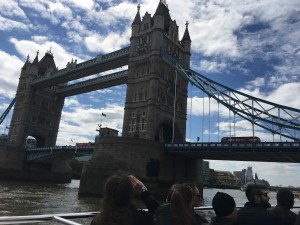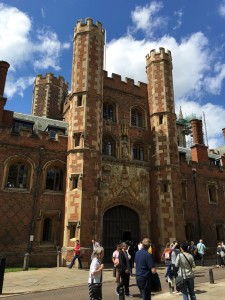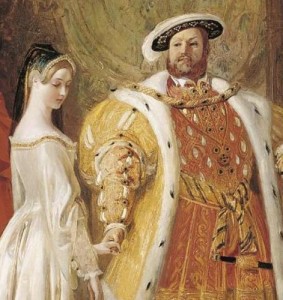 Earlier this year, I spent an unusually sybaritic week sightseeing and overindulging with a friend from the Philippines on her first trip to London: Hampton Court (food), Harry Potter World (food) and Harrods (and more food). Then there was a river cruise with a highly amusing Cockney guide, a train ride or two, and miles and miles of walking through the city parks and along the Thames.
Earlier this year, I spent an unusually sybaritic week sightseeing and overindulging with a friend from the Philippines on her first trip to London: Hampton Court (food), Harry Potter World (food) and Harrods (and more food). Then there was a river cruise with a highly amusing Cockney guide, a train ride or two, and miles and miles of walking through the city parks and along the Thames.
We saw a musical in the West End from the from row of the balcony. We viewed London from the top of a double decker bus, and then from The Ned’s new roof garden in the City. We walked across Charing Cross Bridge and took photos of the Houses of Parliament in the twilight. We waved to the Queen at Buckingham Palace, and again at Windsor. Unfortunately, she wasn’t free to join us for afternoon tea at Harrods, but we wore our tiaras just in case she changed her mind. We brunched at Borough Market, lunched in a pub by the Thames, and dined at a curry house in Surrey. We drank Butterbeer at Harry Potter World – and I can promise you I won’t be doing that again. I have the souvenir mug, if only to remind me to keep a wide berth! (But the rest of that day was a blast, and we were definitely NOT the only visitors over twelve.) We sang thunderously at a Sunday service in the prettiest, white weatherboard church beside a duck pond. We chatted with the deer in Bushy Park and popped in to see Peter Pan in Kensington Gardens. We dashed along Piccadilly in the rain, dodging puddles and pedestrians, armed with umbrellas we had bought at Waterloo… we were the archetypal tourists. It was a non-stop, whirlwind week and the most amazing fun. Even now I can’t think how we squeezed so much into a mere eight days. Or so much eating!
Yet the event we both remember best was a morning at Hampton Court, when the rain drove us out of the  Wilderness, across the rose garden and in through the huge gateway to the Clock Court…
Wilderness, across the rose garden and in through the huge gateway to the Clock Court…
Once upon a time, in primary school, I did a project on the history of London, which included trips to the Monument, the Tower of London, the Houses of Parliament and Hampton Court. Our class even produced a short play about Henry VIII and his six wives. I was Katherine Howard in pink satin overlaid with black lace. And I had to scream piercingly as I was dragged off to the Tower. As a result, I became obsessed with all things Tudor.
Hampton Court Palace has particularly strong ties to the Tudor Dynasty. Located on the Thames, ten miles upriver from the city of London, it was originally owned by Cardinal Wolsey, a powerful and ambitious statesman and chief advisor to King Henry VIII for many years. He fell from favour, however, when he was unable to procure Henry’s divorce from his first wife, the Spanish princess Katherine of Aragon. Accused of treason, his titles and properties confiscated, Wolsey died en route to his trial. Cheerfully requestioning Hampton Court for himself, King Henry made himself at home, with his new and heavily pregnant bride, Anne Boleyn. The Palace would become a firm favourite with both Henry and his older daughter, Mary.
Yet there is more to Hampton Court than the Tudors. In the 17th century, William and Mary of Orange added a huge Baroque extension and landscaped gardens the designer hoped would rival Versailles. In the 18th century, George I added a Hanoverian flavour, employing the architect Vanbrugh to make improvements and finish the work begun by the Stuarts. So, a tour of the Palace is like travelling through time, from the vast Tudor kitchens and the beautiful chapel with its deep blue, star-spangled ceiling, to the formal state rooms designed by Sir Christopher Wren, and finally to Vanbrugh’s Georgian suite.
As you may have gathered, I have a long-standing love affair with Hampton Court, as much for its extensive grounds as its sumptuous palace. In spring, the Wilderness, on the north side of the palace, is awash with daffodils, and three-hundred-year-old yew trees line the world’s oldest maze. In summer, the walled rose garden is sublime, lush with roses of every imaginable colour. The walled kitchen garden, recently restored to its 18th century splendour, is planted with orderly rows of historically accurate fruit and vegetable crops. In the summer months, you can even buy the produce grown there. Behind the kitchen garden, the latest addition is a magical, mediaeval themed playground for the kids, built on Henry VIII’s jousting yard.
To the east and south of the palace, lies a series of formal gardens, designed in the late 17th century by Lancelot ‘Capability’ Brown, who also planted a grape vine there. Today the ‘Great Vine’ is the world’s longest single grapevine, and is housed in a large conservatory where it still produces a yearly crop of sweet black grapes. These grapes were once kept solely for the king’s table, but these days they are sold to the public. And if your legs need stretching, there are a further 750 acres of deer park and riverside walks along the Thames towards Kingston.
 But I am drifting. On a rather drear Spring morning, awash with mizzling rain, we ducked into the palace and donned headphones to listen to some fascinating insights into life at Hampton Court through the ages, following an architectural timeline through Tudor, Stuart and Hanoverian England. We were down in the kitchens, watching a kitchen boy light the fire with a flint and straw when we were rounded up by a troupe of travelling players, and carried off to the Great Hall, where, in time-honoured tradition, we settled down to watch a short production that had been written specifically for Hampton Court Palace by playwright Sarah Dickenson. In Mediaeval England, the Royal Family would not have attended plays with the commoners in the London playhouses. Instead, acting troupes would occasionally be asked to perform at Court. In the early 17th century, Shakespeare and his troupe performed many times at Hampton Court Palace.
But I am drifting. On a rather drear Spring morning, awash with mizzling rain, we ducked into the palace and donned headphones to listen to some fascinating insights into life at Hampton Court through the ages, following an architectural timeline through Tudor, Stuart and Hanoverian England. We were down in the kitchens, watching a kitchen boy light the fire with a flint and straw when we were rounded up by a troupe of travelling players, and carried off to the Great Hall, where, in time-honoured tradition, we settled down to watch a short production that had been written specifically for Hampton Court Palace by playwright Sarah Dickenson. In Mediaeval England, the Royal Family would not have attended plays with the commoners in the London playhouses. Instead, acting troupes would occasionally be asked to perform at Court. In the early 17th century, Shakespeare and his troupe performed many times at Hampton Court Palace.
Today’s historical drama is set in the summer of 1533, as the new Royal couple move into the Palace. The play begins in the Great Hall, where renovations are under way, and Anne is heavily pregnant with Henry’s desperately needed son and heir, and being a thoroughly stroppy cow, doubtless thanks to hormones and the ill-informed belief she is having a boy.
As the tale unfolds, we follow the players through the Tudor palace, who gradually expose the hopes and fears of this infamous King of England, and the complex political machinations of his courtiers. There are ten performers: Henry and Anne of course, with Thomas Cromwell and Thomas Cranmer, the politician and the pontiff closest to Henry at the time. Anne’s waiting woman, Bess, is Anne’s dubious ally. Jane Seymour has just arrived at Court with her brother Edward, from the household of the dethroned Queen Catherine, and soon, herself, to be queen number three. Two townsfolk, George and Mary provide voices for the commoners, while Grace, minstrel and narrator, weaves the threads together.
We were entranced by the performance, and the only nuisance was that the troupe split up at one point to tell opposing tales, but we could only follow one of the lead players. Nonetheless, we were both educated and entertained by this lively interpretation of an infamous era of British history. And I find I am still besotted with all things Tudor.
